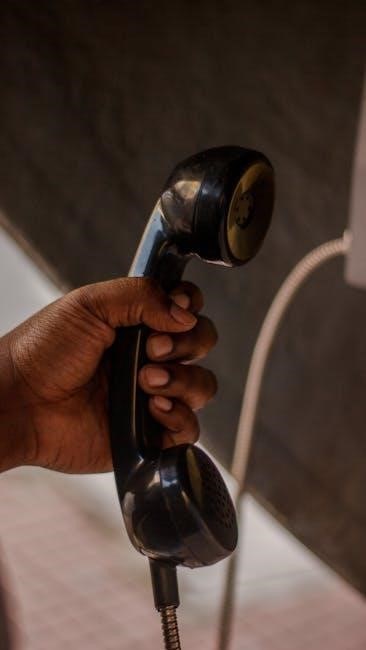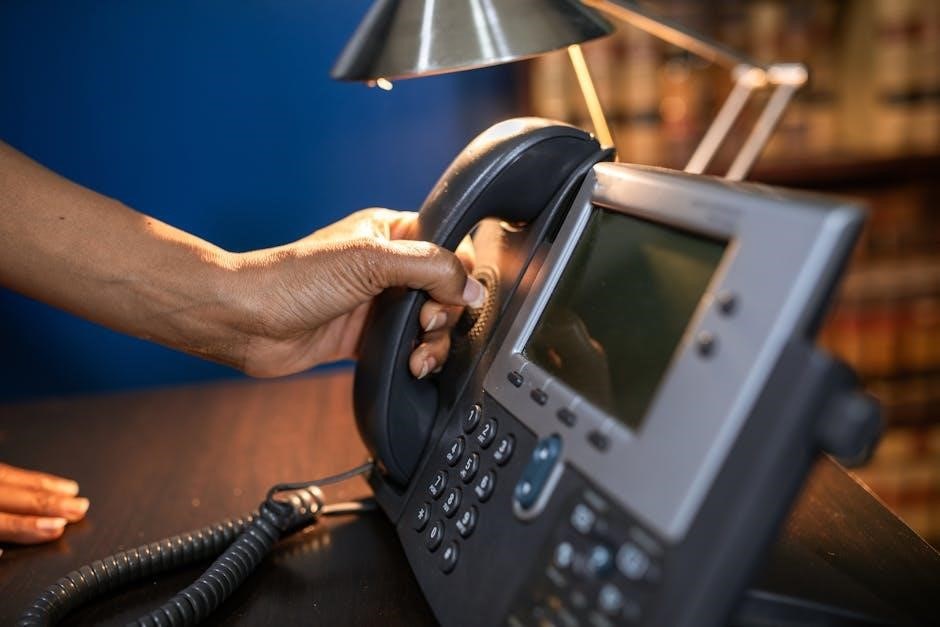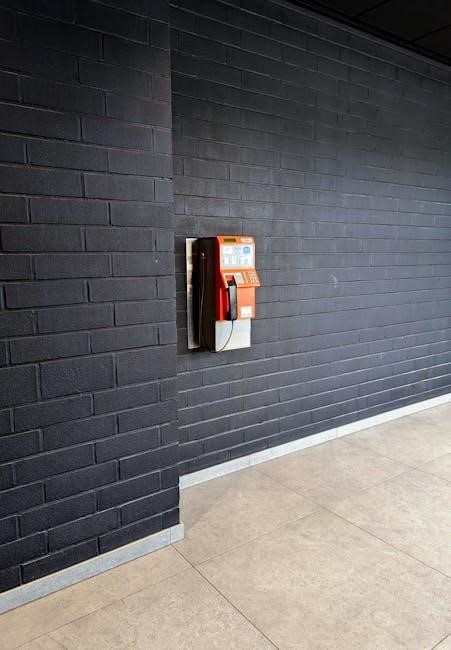
Manual Call Points are essential devices in fire alarm systems, allowing individuals to manually trigger an alert in case of a fire. They ensure quick evacuation and are crucial for safety in emergencies.

Definition and Purpose
A Manual Call Point (MCP) is a device designed to allow individuals to manually activate a fire alarm system in the event of a fire or emergency. These devices are typically installed in public or commercial buildings and are a critical component of fire safety systems. The primary purpose of an MCP is to provide a reliable means for occupants to raise an alarm, ensuring timely evacuation and emergency response. By triggering the alarm, it alerts everyone in the building to potential danger, enabling swift action to prevent harm. The Manual Call Point is often referred to as a “break glass” unit, as it typically features a glass or plastic panel that must be broken or pressed to activate the alarm.
The purpose of MCPs extends beyond just sounding an alarm; they also serve as a visible indicator of emergency activation points. This ensures that everyone in the building knows where to find the means to alert others in case of a fire. Their simplicity and accessibility make them indispensable in fire safety strategies, complementing automated detection systems by allowing human intervention when necessary.

Types of Manual Call Points
Manual Call Points come in various types, including conventional, addressable, outdoor, and specialized versions. Each type is designed for specific environments and requirements, ensuring reliable fire alarm activation in diverse settings.
3.1 Conventional Manual Call Points
Conventional Manual Call Points (MCPs) are simple, reliable devices used in fire alarm systems to manually trigger an alert. They consist of a physical mechanism, such as a lever or button, which, when activated, sends an electrical signal to the fire alarm control panel. These devices are often installed in public areas, stairwells, and corridors, ensuring easy access during emergencies. Conventional MCPs operate on a zone-based system, where each call point is connected to a specific zone, making it easier to identify the location of the alarm. They are known for their simplicity, durability, and low maintenance requirements, making them a cost-effective solution for smaller buildings or systems with basic fire safety needs. However, they lack the advanced features of addressable systems, such as identifying the exact location of the activated call point. Despite this, conventional MCPs remain a vital component in many fire safety setups due to their ease of installation and straightforward operation.
3.2 Addressable Manual Call Points
Addressable Manual Call Points (MCPs) are advanced devices in fire alarm systems that provide precise identification of the activation location. Unlike conventional systems, addressable MCPs use a unique address or identifier for each call point, allowing the fire alarm control panel to pinpoint the exact location of the alert. This feature is particularly beneficial in large buildings, campuses, or complexes where multiple call points are installed. Addressable systems utilize digital communication between the call point and the control panel, enabling real-time monitoring and diagnostics. They offer enhanced reliability and flexibility, as they can be programmed to customize responses based on specific requirements. Additionally, addressable MCPs reduce installation costs by minimizing the need for extensive wiring. Their ability to provide detailed information ensures a faster and more efficient emergency response, making them a preferred choice for modern fire safety systems in commercial and industrial settings. This technology ensures that every second counts during an emergency.
3.3 Outdoor Manual Call Points
Outdoor Manual Call Points are specifically designed to withstand harsh environmental conditions, ensuring reliable fire alarm activation in external settings. These devices are built with durable materials and weather-resistant enclosures to protect against rain, snow, extreme temperatures, and vandalism. Often equipped with IP67 ratings, they are dustproof and waterproof, maintaining functionality even in challenging outdoor environments. Typically installed in areas like parking lots, stadiums, or campuses, they provide critical fire safety in open spaces. Outdoor call points may feature tamper-proof mechanisms to prevent unauthorized use. Their visibility is enhanced with bright colors or integrated lighting, ensuring they remain accessible and noticeable. Regular maintenance is crucial to ensure their effectiveness, as environmental factors can impact performance. These call points are essential for comprehensive fire safety systems, bridging the gap between indoor and outdoor emergency response needs. Their robust design ensures they remain operational when emergencies arise, safeguarding people and property in various outdoor scenarios.
3.4 Specialized Manual Call Points
Specialized Manual Call Points are tailored for unique environments or specific applications, offering enhanced functionality beyond standard models. These devices are designed to meet the needs of particular industries or locations, such as chemical plants, hospitals, or historical buildings. For instance, explosion-proof manual call points are used in hazardous areas where flammable materials are present, preventing ignition risks. Some specialized models feature anti-microbial coatings, ideal for healthcare settings to reduce infection spread. Others may include tamper-proof mechanisms to prevent accidental activation in public areas. These call points often combine advanced technology, such as addressable systems, with robust construction to suit their intended use. Their adaptability ensures fire safety needs are met in diverse and challenging environments, providing reliable emergency response solutions. Specialized manual call points emphasize safety, durability, and customization, making them indispensable in specific scenarios where standard devices may fall short.

How Manual Call Points Work
Manual Call Points operate by allowing individuals to trigger a fire alarm manually in emergency situations. When activated, they send a signal to the fire alarm control panel, which then sounds the alarm throughout the building. Typically, these devices feature a lever, button, or glass panel that, when broken or pressed, completes an electrical circuit. This activation alerts occupants to evacuate and notifies the fire brigade or monitoring center. Some models include addressable technology, enabling the control panel to identify the exact location of the activated call point; Additionally, they often have visual indicators, such as flashing lights, to confirm activation. The simplicity of their design ensures rapid response during emergencies, making them a critical component of fire safety systems. Their reliability and ease of use contribute to timely evacuations and effective emergency management.
Components of a Manual Call Point
A Manual Call Point consists of several key components that ensure its proper functioning. The outer casing is typically made of durable materials like plastic or metal, designed to withstand environmental factors. Inside, there is an electrical circuit that remains open until the device is activated. The activation mechanism, such as a lever, button, or breakable glass panel, triggers the circuit to close, sending a signal to the fire alarm control panel. Some models include addressable technology, which allows the control panel to identify the specific location of the activated call point. Additionally, many Manual Call Points feature LED indicators to confirm activation and provide visual feedback. These components work together to ensure reliable and efficient operation during emergencies, making them a vital part of fire safety systems.

Installation Requirements
Manual Call Points must be installed in accordance with local fire safety regulations and standards. They are typically mounted on walls at a height of approximately 1.2 to 1.5 meters above floor level to ensure accessibility. The devices should be placed in visible and accessible locations, such as corridors, staircases, and near exits, to facilitate quick activation during emergencies. A reliable power supply is essential, and wiring must comply with electrical safety standards. For addressable systems, each call point is connected to the fire alarm control panel via a dedicated circuit. Proper installation ensures the device functions correctly and provides clear communication to the fire alarm system. Regular testing and maintenance are also required to guarantee operational readiness. Compliance with these installation requirements is critical to ensure the safety of occupants in case of a fire emergency.
Maintenance and Testing
Regular maintenance and testing of Manual Call Points are crucial to ensure their reliability and functionality in emergencies. Inspection should include checking for physical damage, proper installation, and functionality of buttons and contacts. Testing involves activating the call point to verify that it triggers the fire alarm system correctly. Additionally, wiring and connections should be inspected for integrity, and batteries (if applicable) must be checked for charge and replaced as needed. A log of maintenance activities should be kept to ensure compliance with safety standards. Testing should be conducted at least annually, or as specified by local regulations, to guarantee that all components operate seamlessly. Proper maintenance not only ensures the safety of occupants but also prevents false alarms, which can undermine the system’s credibility. Regular servicing by trained professionals is essential to maintain the effectiveness of Manual Call Points in fire safety systems.
Legal and Safety Standards
Manual Call Points must comply with stringent legal and safety standards to ensure reliability and effectiveness in emergencies. These standards, often outlined by local fire safety regulations and international codes like EN 54 in Europe and NFPA 72 in the U.S., dictate installation, testing, and maintenance requirements. Key standards include proper placement height, visibility, and accessibility to ensure all individuals, including those with disabilities, can activate the devices easily. Regular testing and inspection schedules are mandated to verify functionality and integrity. Certification from recognized bodies is required to confirm that Manual Call Points meet specified safety criteria. Compliance with these standards is critical to avoid legal penalties and ensure public safety. Additionally, ongoing inspections by trained professionals and adherence to documentation protocols are essential to maintain compliance and operational readiness; These standards ultimately safeguard lives by ensuring Manual Call Points perform reliably when needed most.
Advantages of Manual Call Points
Manual Call Points offer several significant advantages, making them a crucial component of fire safety systems. Their simplicity ensures reliable operation during emergencies, providing a direct way to alert others of potential dangers. One key benefit is their ability to initiate a rapid response, minimizing delays that could worsen a fire situation. They also serve as a backup to automatic fire detection systems, ensuring redundancy in critical situations; Additionally, Manual Call Points are cost-effective, requiring minimal maintenance compared to advanced systems. Their universal accessibility means anyone can activate them, promoting quick evacuation and enhancing overall safety. Furthermore, their presence raises fire safety awareness among occupants, encouraging vigilance and proactive behavior. These devices are particularly valuable in high-risk areas or where automatic systems may fail to detect fires promptly. Their durability and ease of use make them a practical choice for ensuring safety in various environments.

Disadvantages of Manual Call Points
While Manual Call Points are vital for fire safety, they have certain drawbacks; One major disadvantage is their susceptibility to false alarms, which can lead to unnecessary evacuations and disruptions. Additionally, their effectiveness heavily relies on human intervention, meaning delays or failure to activate them can compromise safety. The devices may also be prone to tampering or accidental activation, further increasing the risk of false alarms. Furthermore, Manual Call Points lack the sophistication of automated systems, which can detect fires earlier and more accurately. Their design may not suit all environments, particularly outdoor or harsh conditions, where they may be less reliable. Maintenance requirements, although minimal, still necessitate regular checks to ensure functionality. Lastly, they may not integrate seamlessly with advanced fire safety systems, potentially limiting their effectiveness in modern, high-tech environments. Despite these limitations, Manual Call Points remain a critical component of fire safety protocols.
Common Applications
Manual Call Points are widely used in various settings to ensure fire safety. They are commonly installed in public buildings, such as schools, hospitals, offices, and shopping centers, where rapid fire detection and evacuation are critical. These devices are also found in industrial facilities, hotels, and residential complexes, serving as a reliable means to alert occupants and authorities in emergencies. Additionally, Manual Call Points are often deployed in transportation hubs like train stations, airports, and bus terminals, where large crowds gather. Their presence in entertainment venues, such as theaters and stadiums, further highlights their importance in safeguarding public spaces. Moreover, they are essential in high-risk areas like laboratories, warehouses, and parking garages, where fire hazards may be more pronounced. Overall, Manual Call Points play a vital role in protecting lives and property across diverse environments.

Comparisons with Other Fire Alarm Systems
Manual Call Points (MCPs) are distinct from other fire alarm systems, as they rely on manual activation rather than automated detection. Unlike smoke or heat detectors, which trigger alarms automatically, MCPs require human intervention to initiate an alert. This makes them a critical backup system, ensuring that even if automated detectors fail, individuals can still raise an alarm. Compared to addressable fire alarm systems, which provide precise location details, MCPs often signal a general alert without specifying the exact source of the fire. However, MCPs are simpler, more reliable, and less prone to false alarms than some automated systems. They are also more accessible in situations where automated detection may not be feasible or cost-effective. While modern systems like aspirating smoke detectors offer advanced sensitivity, MCPs remain indispensable for their straightforward, human-centric approach to fire safety. Their simplicity ensures they are a vital component in any comprehensive fire alarm strategy.
User Responsibilities
Users play a crucial role in ensuring the effectiveness of manual call points (MCPs). It is essential for individuals to understand the proper operation and purpose of MCPs to avoid misuse. Regular inspection of MCPs is vital to ensure they are functioning correctly and are free from damage. Users should never tamper with or disable MCPs, as this can compromise fire safety. In the event of a fire, individuals must activate the MCP promptly to alert others and initiate evacuation procedures. Additionally, users should familiarize themselves with the location of all MCPs within a building to ensure quick access during emergencies. Training and awareness programs can help users understand their responsibilities and the importance of MCPs in fire safety systems. By adhering to these guidelines, users can contribute significantly to maintaining a safe environment and ensuring the system operates effectively when needed.
Case Studies and Examples
A notable example of the effectiveness of manual call points (MCPs) can be seen in a large office building where a fire broke out in the basement. An employee noticed smoke and immediately activated the MCP, which alerted the entire building. The prompt activation led to the evacuation of over 500 people within minutes, preventing any casualties. This case highlights the critical role of MCPs in ensuring timely responses to fire emergencies. Another example is in a school where a student accidentally triggered an MCP during a drill, demonstrating the ease of use and reliability of these devices. Such real-world scenarios underscore the importance of MCPs in safeguarding lives and property. These examples also emphasize the need for proper training and regular maintenance to ensure the devices function correctly when needed.

History of Manual Call Points
Manual Call Points (MCPs) have a long history dating back to the late 19th century when basic fire alarm systems were first developed. Initially, these devices were simple mechanical systems that triggered an alarm when activated. In the early 20th century, MCPs evolved to incorporate electrical components, making them more reliable and widespread in commercial and public buildings. The 1980s saw the introduction of addressable MCPs, which could identify specific locations of activations, enhancing response efficiency. Over time, advancements in technology led to more sophisticated designs, including weather-resistant models for outdoor use and specialized versions for hazardous environments. Today, MCPs are a critical component of modern fire safety systems, with ongoing innovations focusing on integration with other security technologies and improved user accessibility. Their development reflects the growing emphasis on fire safety and the need for reliable emergency response solutions.

Design and Aesthetics
Manual Call Points are designed to be highly visible and accessible, ensuring quick activation in emergencies. Their design typically features a red color scheme and standardized shapes to maintain consistency across installations. Durability is a key consideration, with materials chosen to withstand heavy use and environmental conditions. Aesthetics play a role in modern installations, as MCPs are often designed to blend seamlessly with architectural styles while maintaining functionality. Some models offer sleek, low-profile designs that complement contemporary interiors without compromising safety. Additionally, advancements in design have led to customizable options, allowing MCPs to align with specific building aesthetics. The integration of LED indicators and illuminated labels enhances visibility while maintaining a modern appearance. These design elements ensure that Manual Call Points remain both functional and visually appealing, adapting to various environments while meeting safety standards.

Integration with Other Systems
Manual Call Points are often integrated with other fire safety and building management systems to enhance functionality and response. They can be connected to fire suppression systems, ensuring automatic activation of sprinklers or clean agents upon alarm. Integration with smoke ventilation systems allows for coordinated smoke clearing, improving evacuation routes. Additionally, MCPs can interface with Building Management Systems (BMS) for real-time monitoring and centralized control. Some systems incorporate public address (PA) integration, enabling voice alerts and instructions during emergencies. Integration with emergency lighting systems ensures illumination of escape routes upon activation. Modern MCPs may also connect to networked fire alarm panels, providing detailed event logging and system diagnostics. This seamless integration ensures a comprehensive and efficient response to fire incidents, streamline system management, and enhance overall safety. Proper integration is critical for maximizing the effectiveness of Manual Call Points in protecting people and property.
Environmental Considerations
Environmental considerations play a crucial role in the installation and operation of Manual Call Points (MCPs). These devices must withstand various environmental conditions, including temperature fluctuations, humidity, and exposure to outdoor elements. Outdoor MCPs are typically designed with weather-resistant materials to ensure reliability in harsh climates. Additionally, MCPs should be energy-efficient, with low power consumption to minimize their environmental impact. Some models incorporate LED indicators that consume less energy while providing clear visual feedback. Proper installation in protected areas can also reduce wear and tear from environmental factors. Compliance with environmental regulations, such as those related to hazardous materials and waste disposal, is essential. manufacturers often use recyclable materials to align with sustainability goals. Regular maintenance is recommended to ensure MCPs remain functional in demanding environments. By addressing these environmental factors, MCPs can reliably serve their purpose while minimizing their ecological footprint.
Future Trends
Future trends in Manual Call Points (MCPs) are expected to focus on enhanced connectivity, integration, and sustainability. Many MCPs will likely incorporate Internet of Things (IoT) capabilities, enabling real-time monitoring and remote diagnostics. This will allow for proactive maintenance and faster response times. Additionally, advancements in artificial intelligence (AI) could enable smarter systems that analyze patterns to reduce false alarms. Environmental sustainability will also play a role, with manufacturers prioritizing eco-friendly materials and energy-efficient designs. The integration of MCPs with other safety systems, such as building management and emergency response platforms, will become more seamless. Furthermore, user-friendly designs and touchless activation methods may emerge to improve accessibility and hygiene. As technology evolves, MCPs will continue to adapt to meet the demands of modern fire safety standards while addressing global environmental challenges.
FAQs
- What is a manual call point?
A manual call point (MCP) is a device used to manually trigger a fire alarm, alerting occupants of a potential fire hazard.
- How does a manual call point work?
When activated, it sends a signal to the fire alarm system, sounding alarms and initiating evacuation procedures.
- Where should manual call points be installed?
They are typically placed near exits, staircases, or strategic locations for easy access during emergencies.
- What are the types of manual call points?
They include conventional, addressable, outdoor, and specialized models, each designed for specific environments and needs.
- How often should manual call points be tested?
Regular testing, often monthly or quarterly, ensures functionality and compliance with safety regulations.
- What are the advantages of manual call points?
They provide a reliable, immediate way to alert others in emergencies, enhancing safety and response time.
- Are manual call points required by law?
Yes, they are mandated in many jurisdictions as part of fire safety regulations to ensure public safety.
- Can manual call points integrate with other systems?
Modern MCPs can integrate with building management or security systems for enhanced functionality.
- What future trends might impact manual call points?
Advancements like IoT connectivity, AI, and eco-friendly designs are expected to shape their evolution.
Leave a Reply
You must be logged in to post a comment.